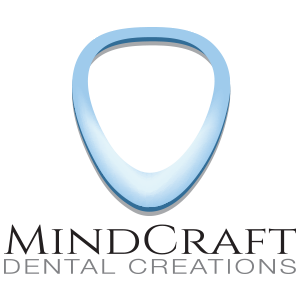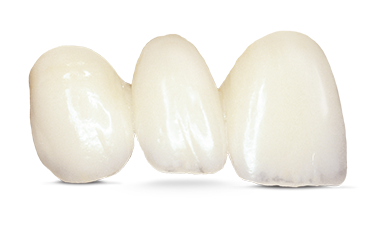
IPS Empress®
A versatile all-ceramic product, with a wide range of restorative options. From inlays and onlays, to crowns and veneers, IPS Empress® is a multifaceted restorative product with the esthetics only all-ceramics can offer.
IPS Empress is recommended for anterior single crowns, inlays, onlays and veneers. IPS Empress veneer is recommended for anterior restorations to block out mild staining, close diastemas or to just enhance esthetics.
IPS Empress should not be used on patients with malfunctional occlusion such as bruxers or clenchers. IPS Empress should not be used as abutments for cast partials. IPS Empress should not be used in situations when preparation requirements cannot be achieved. IPS Empress veneer is not to be used in the case of correcting severe stain situations such as tetracycline.
IPS Empress should not be used on patients with malfunctional occlusion such as bruxers or clenchers. IPS Empress should not be used as abutments for cast partials. IPS Empress® should not be used in situations when preparation requirements cannot be achieved. IPS Empress® veneer is not to be used in the case of correcting severe stain situations such as tetracycline.
Anterior full-coverage crowns require a chamfer with 1.5 – 2 mm facial reduction, 1 – 1.5 mm lingual contact clearance, 1.5 – 2 mm incisal reduction 1 – 1.5 mm reduction at the gingival margin with rounded internal line angles; or a shoulder with 1 mm lingual reduction, 2 mm incisal reduction, 1.5 mm labial reduction, 1 mm 360° rounded shoulder.
Posterior full-coverage crowns require a chamfer margin with 1.5 – 2 mm occlusal reduction, 1.5 mm buccal and lingual reduction with rounded internal line angles; or a shoulder with 1.5 – 2 mm occlusal reduction, 1.5 mm buccal and lingual reduction and 1 – 1.5 mm gingival margin reduction with rounded internal line angles.
Inlays and onlays require 1.5 – 2 mm isthmus width, 1 – 1.5 mm wide gingival floor with rounded internal line angles and butt joint margins.
Veneers require a uniform preparation and lingual reduction to increase strength. A medium-grit round-ended diamond is used to join the depth cut grooves to establish a uniform preparation and porcelain thickness of at least 1 mm. The diamond is angled to eliminate undercuts and establish a butt joint on the lingual aspect of the preparation. The incisal edge should be rounded to eliminate sharp line angles.
Chamfer Margins – Correct preparation of the chamfer margins interproximally allows the appropriate bulk of porcelain.
A Slice Preparation – This technique enables the ceramist to close the space and avoid unnatural lingual contours.
Adhesive bonding/dual cure materials including:
Variolink (Ivoclar Vivadent)
Choice (Bisco, Inc.)
Insure (Cosmedent, Inc.)
If an adjustment is required on the ceramic, ALWAYS CEMENT OR BOND INTO PLACE BEFORE PROCEEDING, then use a fine diamond with water and air to keep the crown cool. To contour the ceramic, polish with a pink rubber wheel and diamond polishing paste (Brassler, Shofu and Vident).
Caution: Do NOT attempt to fire porcelain. It must be done in precisely calibrated ovens at special temperatures and vacuum settings.
For best results, return crown for reglaze firing to lab.
D2740 Crown
D2610 Inlay for 1 surface
D2620 Inlay for 2 surfaces
D2630 Inlay for 3 surfaces
D2962 Labial Veneer
D2783 Crown 3/4 Porcelain Ceramic (does not include veneers)
Full-contour zirconia is so versatile, it can be used in almost any situation from singles, bridges with any combination of abutments and pontics, inlay bridges, Maryland type bridges and screw retained implants. Also an esthetic alternative to a PFM with metal occlusion due to limited space.
Contraindications include:
When esthetic expectations are high and it is important that the restorations match surrounding natural dentition or other existing restorations
If bonding is necessary to retain the restoration, bond strength is weaker and less predictable than other ceramics
Shoulder preparation not needed. A mild champfer or a feather edge margin is good. 1mm buccal, lingual and occlusal reduction is ideal, but can go to .5mm in some areas, when reduction is limited.
Minimum occlusal reduction of 0.5 mm; 1 mm is ideal.
Adjustments and polishing: Adjust Full-contour zirconia crowns and bridges using water and air spray to keep the restoration cool and to avoid micro-fractures with a fine grit diamond. If using air only, use the lightest touch possible when making adjustments. A football-shaped bur is the most effective for occlusal and lingual surfaces (on anterior teeth); a tapered bur is the ideal choice for buccal and lingual surfaces.
Polish Full-contour zirconia restorations with the porcelain polishing system of your choice.
Full-contour zirconia may be cemented using a resin reinforced glass ionomer such as Relyx Luting cement. When a greater bond is needed do to the lack of a retentive preparation, use resin cement like Relyx Unicam or Relyx Ultimate.
Before cementing all Full-contour zirconia crowns, the interior surface of the crown needs to be cleaned with Ivoclean (Ivoclar Vivadent; Amherst N.Y.). This is critical in assuring maximum bond strength.
Solid zirconia requires a cast gold type preparation. If adjustments are needed, use zirconia specific diamonds and rubber wheels polishing with diamond paste.
D2740 Crown – Porcelain/Ceramic Substrate
D6245 Pontic Porcelain/Ceramic
D6740 Abutment Crown Porcelain/Ceramic
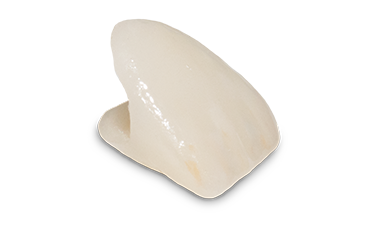
ArgenZ™ Anterior
An alternative to lithium disilicate, providing the highest translucency paired with optimal strength.

cubeX²®
Used for highly esthetic anterior treatments, cubeX²® combines the translucency from lithium disilicates with the durability of zirconia.
A high-esthetic alternative to IPS e.max® restorations, cubeX2 cubic zirconia is indicated for single crowns and three-unit bridges in anterior and posterior restorations. Its high resiliency makes it suitable for posterior restorations when esthetics demand more translucency than conventional full-contour zirconia.
None.
The ideal preparation is a 0.8 mm chamfer or rounded shoulder. A feather-edge margin with 1.0-1.5 mm of occlusal reduction is also acceptable.
Ceramir® Crown & Bridge (Doxa Dental)
RelyX™ Luting Cement (3M ESPE)
GC Fuji Plus™ (GC America)
DAL recommends the Brasseler USA® Dialite® ZR Kit for finishing and polishing cubeX2. This two-step system allows you to quickly achieve maximum surface smoothness, enhancing your restoration’s longevity and minimizing wear to opposing dentition. Use adequate water when adjusting.
To successfully remove saliva, the crown should be cleaned with Ivoclean, a zirconia oxide solution from Ivoclar Vivadent. This zirconia oxide solution is placed inside the restoration for 20 seconds and then rinsed out.
D2740 Crown – Porcelain/Ceramic Substrate
D6245 Pontic Porcelain/Ceramic
D6740 Abutment Crown Porcelain/Ceramic
IPS e.max press is indicated for full anterior or posterior crowns, veneers, inlays, onlays,as well as three-unit bridges having only one pontic with the second bicuspid as the most distal abutment.
Bridges which include molars, Maryland style bridges and bridges which have a short vertical height that does not allow for adequate connector height.
Posterior full-coverage crown requires a chamfer or shoulder margin. A circular shoulder is prepared with rounded inner edges or a chamfer at an angle of 10-30°: the width of the shoulder/chamfer is approx. 1 mm. Occlusal reduction is 1.5 – 2 mm: axial reduction (buccal, lingual and interproximal) is 1.5 mm with rounded internal line angles.
IPS e.max layered – can be either cemented using a resin reinforced glass ionimer such as Relyx Luting cement. Or bonded using a resin cement, when extra strength is needed due to lack of retention on the prep, use a resin cement such as Relyx Unicem or Relyx Ultimate.
If adjustments are needed, use fine diamonds with water and light pressure. Always remove the crown when adjusting or bond/cement crown before adjustments are made.).
D2740 Crown
D2610 Inlay for 1 surface
D2620 Inlay for 2 surfaces
D2630 Inlay for 3 surfaces
D2962 Labial Veneer
D2783 Crown 3/4 Porcelain Ceramic (does not include veneers)

IPS e.max®
IPS e.max® delivers shading and translucency which resembles the esthetics of natural enamel. Fabricated using CAD/CAM technology, IPS e.max® is ideal for anterior restorations.

Bruxzir®
Milled from solid zirconia, Bruxzir® offers both a strength and beauty which is ideal for bridges, implant-retained crowns, and full-arch prostheses.
BruxZir Zirconia is so versatile, it can be used in almost any situation from singles, bridges with any combination of abutments and pontics, inlay bridges, Maryland type bridges and screw retained implants. Also an esthetic alternative to a PFM with metal occlusion due to limited space.
Contraindications include:
When esthetic expectations are high and it is important that the restorations match surrounding natural dentition or other existing restorations
If bonding is necessary to retain the restoration, bond strength is weaker and less predictable than other ceramics
Shoulder preparation not needed. A mild champfer or a feather edge margin is good. 1mm buccal, lingual and occlusal reduction is ideal, but can go to .5mm in some areas, when reduction is limited.
Minimum occlusal reduction of 0.5 mm; 1 mm is ideal.
Adjustments and polishing: Adjust BruxZir zirconia crowns and bridges using water and air spray to keep the restoration cool and to avoid micro-fractures with a fine grit diamond. If using air only, use the lightest touch possible when making adjustments. A football-shaped bur is the most effective for occlusal and lingual surfaces (on anterior teeth); a tapered bur is the ideal choice for buccal and lingual surfaces.
Polish BruxZir zirconia restorations with the porcelain polishing system of your choice.
BruxZir zirconia may be cemented using a resin reinforced glass ionomer such as Relyx Luting cement. When a greater bond is needed do to the lack of a retentive preparation, use resin cement like Relyx Unicam or Relyx Ultimate.
Before cementing all BruxZir zirconia crowns, the interior surface of the crown needs to be cleaned with Ivoclean (Ivoclar Vivadent; Amherst N.Y.). This is critical in assuring maximum bond strength.
Solid zirconia requires a cast gold type preparation. If adjustments are needed, use zirconia specific diamonds and rubber wheels polishing with diamond paste.
D2740 Crown – Porcelain/Ceramic Substrate
D6245 Pontic Porcelain/Ceramic
D6740 Abutment Crown Porcelain/Ceramic
Full-contour zirconia is so versatile, it can be used in almost any situation from singles, bridges with any combination of abutments and pontics, inlay bridges, Maryland type bridges and screw retained implants. Also an esthetic alternative to a PFM with metal occlusion due to limited space.
Contraindications include:
When esthetic expectations are high and it is important that the restorations match surrounding natural dentition or other existing restorations
If bonding is necessary to retain the restoration, bond strength is weaker and less predictable than other ceramics
Shoulder preparation not needed. A mild champfer or a feather edge margin is good. 1mm buccal, lingual and occlusal reduction is ideal, but can go to .5mm in some areas, when reduction is limited.
Minimum occlusal reduction of 0.5 mm; 1 mm is ideal.
Adjustments and polishing: Adjust Full-contour zirconia crowns and bridges using water and air spray to keep the restoration cool and to avoid micro-fractures with a fine grit diamond. If using air only, use the lightest touch possible when making adjustments. A football-shaped bur is the most effective for occlusal and lingual surfaces (on anterior teeth); a tapered bur is the ideal choice for buccal and lingual surfaces.
Polish Full-contour zirconia restorations with the porcelain polishing system of your choice.
Full-contour zirconia may be cemented using a resin reinforced glass ionomer such as Relyx Luting cement. When a greater bond is needed do to the lack of a retentive preparation, use resin cement like Relyx Unicam or Relyx Ultimate.
Before cementing all Full-contour zirconia crowns, the interior surface of the crown needs to be cleaned with Ivoclean (Ivoclar Vivadent; Amherst N.Y.). This is critical in assuring maximum bond strength.
Solid zirconia requires a cast gold type preparation. If adjustments are needed, use zirconia specific diamonds and rubber wheels polishing with diamond paste.
D2740 Crown – Porcelain/Ceramic Substrate
D6245 Pontic Porcelain/Ceramic
D6740 Abutment Crown Porcelain/Ceramic
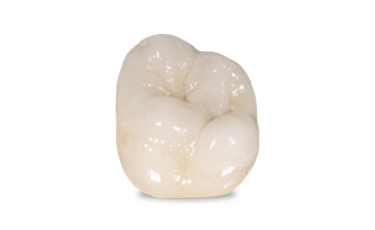
ZirCraft® 2.0
A full-contour zirconia ideal for monolithic restorations, ZirCraft® offers exceptional strength paired with the lifelike esthetics your patient seeks.

ZirCraft® 2.0®
Building on the superior esthetics provided by our ZirCraft® restoration, ZirCraft® 2.0 is our premiere full contour zirconia restorative solution. Indicated for the anterior region, ZirCraft 2.0 utilizes a micro cutback technique combined with lifelike layering which produces a highly esthetic finished product.
Full-contour zirconia is so versatile, it can be used in almost any situation from singles, bridges with any combination of abutments and pontics and inlay bridges. Also an esthetic alternative to a PFM with metal occlusion due to limited space.
Contraindications include:
When esthetic expectations are high and it is important that the restorations match surrounding natural dentition or other existing restorations
If bonding is necessary to retain the restoration, bond strength is weaker and less predictable than other ceramics
Shoulder preparation not needed. A mild champfer or a feather edge margin is good. 1mm buccal, lingual and occlusal reduction is ideal, but can go to .5mm in some areas, when reduction is limited.
Minimum occlusal reduction of 0.5 mm; 1 mm is ideal.
Adjustments and polishing: Adjust Full-contour zirconia crowns and bridges using water and air spray to keep the restoration cool and to avoid micro-fractures with a fine grit diamond. If using air only, use the lightest touch possible when making adjustments. A football-shaped bur is the most effective for occlusal and lingual surfaces (on anterior teeth); a tapered bur is the ideal choice for buccal and lingual surfaces.
Polish Full-contour zirconia restorations with the porcelain polishing system of your choice.
Full-contour zirconia may be cemented using a resin reinforced glass ionomer such as Relyx Luting cement. When a greater bond is needed do to the lack of a retentive preparation, use resin cement like Relyx Unicam or Relyx Ultimate.
Before cementing all Full-contour zirconia crowns, the interior surface of the crown needs to be cleaned with Ivoclean (Ivoclar Vivadent; Amherst N.Y.). This is critical in assuring maximum bond strength.
Solid zirconia requires a cast gold type preparation. If adjustments are needed, use zirconia specific diamonds and rubber wheels polishing with diamond paste.
D2740 Crown – Porcelain/Ceramic Substrate
D6245 Pontic Porcelain/Ceramic
D6740 Abutment Crown Porcelain/Ceramic
A CAD/CAM substitute for traditional PFM our porcelain fused to zirconia can be used for anterior and posterior crowns, crowns over implants and bridges of up to fourteen unit.
Attachment cases
Cases with less than 1 mm clearance
Bruxism
Patients who have broken a PFM crown
Cases that require bonding
The ideal preparation for PFZs is a chamfer margin preparation. If a porcelain labial margin is prescribed, then a shoulder margin preparation is required.
Feather-edge margin preparations are indicated for full-cast restorations.
Resin Ionomer cement (RelyX or RelyX Unicem, 3M ESPE)
Maxcem Elite (Kerr)
Panavia F 2.0 (Kuraray) -ideal for short, tapered preparations
Glass ionomer cement (GC Fuji, GC America)
If an adjustment is required on the ceramic, use a fine diamond with water and air to keep the crown cool.
To contour the ceramic, polish with a pink rubber wheel and diamond polishing paste (Brasseler, Shofu, Vident).
D2740 Crown - porcelain / ceramic substrate
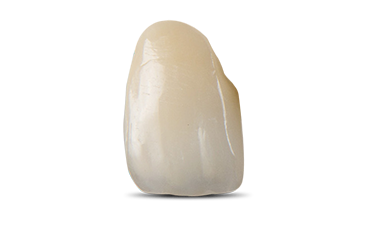
PFZ
Mindcraft’s porcelain fused to zirconia restorations layer porcelain on a zirconia coping, creating an exceptional level of esthetics. The zirconia coping eliminates any worry of unnatural dark areas and allows the porcelain layer to ultimately appear more lifelike.
